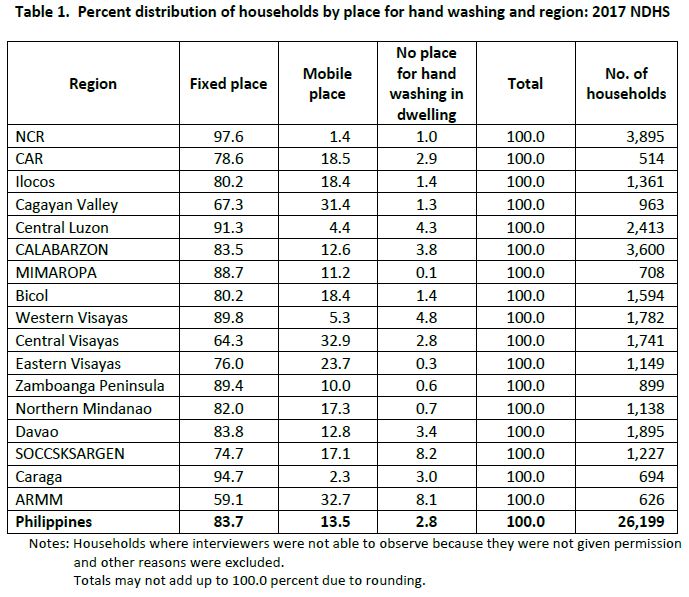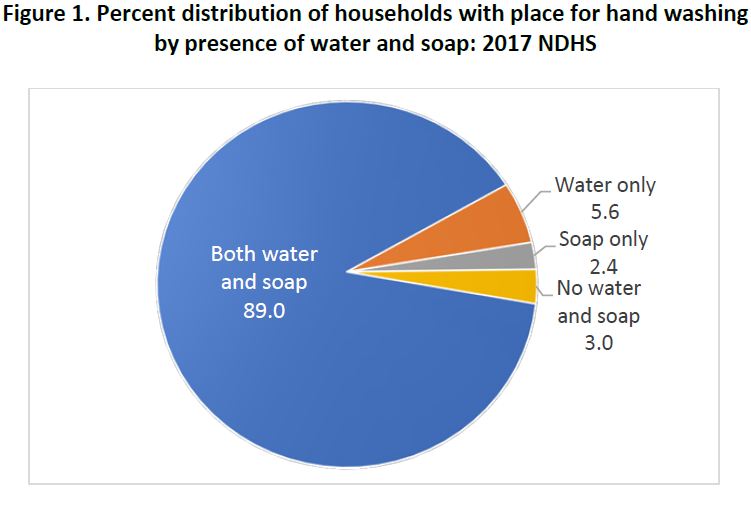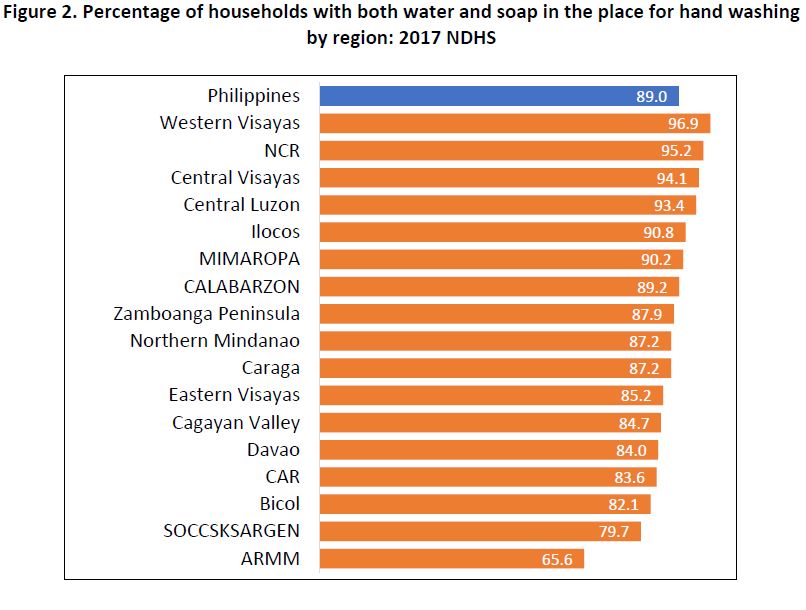
Promoting hand washing in the time of the COVID-19 pandemic
The University of the Philippines Population Institute (UPPI) in collaboration with the Demographic Research and Development Foundation (DRDF) are sharing results of their demographic studies to provide the Philippine context on the possible effects of the coronavirus disease (COVID-19) pandemic. In both the UPPI and DRDF websites, we are publishing a series of research briefs focusing on various aspects of Filipino lives that are affected by COVID-19, in both the short and long terms.
Download PDF here.
Hand washing is important for the prevention of many infectious diseases. Even prior to the coronavirus outbreak, the United Nations Children’s Fund (UNICEF) has been advocating for the practice of hand washing with soap and water as a very simple and highly effective means to control the spread of infectious diarrheal diseases and acute respiratory infections among children. In the time of the coronavirus (COVID-19) pandemic, the Department of Health (DOH) recommends regular hand washing with soap and running water for at least 20 seconds as one of the main protective measures against infection with the novel coronavirus.
While a seemingly simple intervention, regular hand washing will obviously require access to water and soap. In this research brief, we attempt to answer the question, do all Filipinos have access to water and soap? Do Filipino households have a place in the house where they can observe the recommended hand hygiene practice? We use data from the 2017 National Demographic and Health Survey (NDHS) and estimate the number of Filipino households with potential risk for coronavirus infection if the basic requirement of hand washing practices will not be observed by its members. The NDHS is a series of surveys that collects data on a number of population and health indicators. The 2017 round of the survey covered 27,496 households in all regions of the country (refer to PSA and ICF, 20181 for further details about the survey). The survey provides proxy indicators for hand washing behavior that can help inform the government and the private sector in crafting appropriate interventions during this period of the pandemic.
In addition to analyzing the situation at the household level, we also look at the baseline data of the Longitudinal Cohort Study of Filipino Children (LCS2) on hand washing practices of 10-year old children. This will answer the question on how prevalent hand washing practice is among Filipino children.
Availability of water and soap and a place for hand washing in households
In the 2017 NDHS, instead of asking direct questions on hand washing practices which can be subject to over-reporting, the survey interviewers requested the respondents to show the place where the members of their household most often wash their hands. The interviewers then recorded the type of the place for hand washing, the availability of water, and the presence of soap (i.e., soap or detergent in bar, liquid, paste, or powder form) and other cleansing agents (e.g., ash, mud, or sand) in the hand washing place. These indicators are important as studies (e.g., Ram, et al, 20143) show that more frequent hand washing is observed in households with soap and water available in a hand washing location compared to those without.
Results show that nearly all Filipino households (97%) have a place for hand washing, 84 percent have a fixed location while 13 percent do not have a fixed hand washing location (e.g., the household members bring a basin and jug or tabo of water, and soap from inside the house to the outdoor yard to wash their hands) (Table 1). However, three percent of the households nationwide have no place for hand washing in the dwelling unit. Applying this percentage to the projected number of households in 2020, this translates to nearly 700,000 households who may be unable to practice hand washing in their dwelling unit.
Comparing across the regions of the country, having a fixed place for hand washing is most common in Metro Manila (97.6%) which is the epicenter of the COVID-19 outbreak in the country. This is followed by Caraga (94.7%) and Central Luzon (91.3%). On the other hand, about a third of households in Central Visayas (32.9%), Autonomous Region of Muslim Mindanao and ARMM (32.7%), and Cagayan valley (31.4%) do not have a fixed place for hand washing in the dwelling unit. What should be a cause for concern is the total absence of hand washing places in eight percent of households in SOCCSKSARGEN and ARMM. While both regions have reported low incidence of COVID-19 cases so far, addressing this concern at this time may help mitigate the spread of the virus in these regions.

Among households with an observed place for hand washing, a great majority (89.0%) have both water and soap, 6 percent have water only, 2 percent have soap only, and 3 percent have neither water nor soap (Figure 1). The combined 11 percent or about 2.64 million Filipino households where either water or soap is absent in the hand washing area is an indicator of the possible number of households who may find it a challenge to observe regular hand washing.

In addition to having the lowest proportion of households with a place for hand washing in the dwelling unit, ARMM and SOCCSKSARGEN also have the lowest proportion of households with soap and water. Only 66% of households in ARMM and 80% in SOCSKSARGEN were found to have both water and soap in the dwelling unit (Figure 2). In other words, 1 in 3 households in ARMM and 1 in 5 households in SOCCSKSARGEN lack soap and water for hand washing.

The foregoing analysis shows the situation prior to the COVID-19 crisis. With the vigorous promotion of proper hand washing practices, it is expected that more Filipinos will know the right way to wash their hands. However, these promotion strategies will not be effective if there is no soap and water in the home. In all, about 3.3 million households or about 14.7 million Filipinos may not be able to comply with the recommended hand washing practices due either to the absence of place for hand washing in the dwelling unit or the lack of water and soap.
The COVID-19 crisis underscores the need to ensure a steady water supply during this time of the crisis and to ensure the availability of soap, either in the market, or in the relief packages being distributed by government agencies, local government units and private groups to households under lockdown. Households should maintain a fixed location for hand washing and ensure the availability of both water and soap in this location to encourage more frequent hand washing by members of the household.
Hand washing practice among 10-year old Filipino children
Hand washing practices are generally taught in school, at pre-school and elementary levels as part of proper hygiene although the focus is more toward the prevention of diarrheal disease with the practice of handwashing before and after eating and using the toilet. Given these lessons on handwashing in school, how prevalent is hand washing practice among Filipino children?
The UNFPA-funded Longitudinal Cohort Study of Filipino Children is the first national longitudinal study on children age 10 that started in 2016. The baseline survey has a sample of 4,927 children and their main caregivers. In the survey, 10-year old children were asked how often they wash their hands with a soap in a day and when do they usually wash their hands with soap.
The results show that the average number of times children wash their hands in a day is 3 times. There is no difference between children from urban and rural areas. Seventy six percent said they wash their hands before eating, while 50 percent, after eating. Only 19 percent of 10-year old Filipino children wash their hands after using the toilet and a third said, they wash whenever their hands are dirty.
Hand washing with soap for at least 20 seconds is one of the basic strategies promoted by the DOH to combat the spread of coronavirus. This is also one of the hygienic practices we have grown accustomed to, but it seems to have been taken for granted. While children have low risk of COVID-19 infection, instilling in them the value of proper hygienic practices and providing the basic requirements of soap and water, particularly in the home will go a long way in our collective effort to address this public health concern. In schools, the WASH (Water, Sanitation and Hygiene) curriculum should be expanded to include respiratory hygiene and/or etiquette.
Acknowledgement:
We would like to acknowledge the inputs provided by our colleagues from the University of San Carlos Office of Population Studies Foundation (USC-OPS) and the United Nations Population Fund (UNFPA) particularly on hand washing practice among children.
1 Philippine Statistics Authority (PSA) and ICF. (2018). Philippines National Demographic and Health Survey 2017. Quezon City, Philippines, and Rockville, Maryland, USA: PSA and ICF. Retrieved from https://psa.gov.ph/content/national-demographic-and-health-survey-ndhs
2 USC-Office of Population Studies Foundation, Inc. (OPS). (2018). Longitudinal Cohort Study on the Filipino Child. Baseline Survey Technical Report. OPS Report Series No. 2. Retrieved from http://www.opsusc.org
3 Ram P.K., et al. (2014). Validity of rapid measures of handwashing behavior: An analysis of data from multiple impact evaluations in the Global Scaling Up Handwashing Project. Washington, DC: Water and Sanitation Program/The World Bank.
This research brief was prepared by Maria Paz N. Marquez, Elma P. Laguna, Josefina N. Natividad, Grace T. Cruz, Nimfa B. Ogena.
Suggested citation: University of the Philippines Population Institute (UPPI) and Demographic Research and Development Foundation, Inc. (DRDF). (2020, March). Promoting hand washing in the time of the COVID-19 pandemic (UPPI/DRDF Research Brief No. 3). Retrieved from https://www.uppi.upd.edu.ph/sites/default/files/pdf/COVID-19-Research-Brief-03.pdf.
Share
